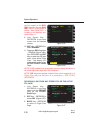
System Operation
3-16
GNS-XL Flight Management System
Rev. 3
Oct/02
3. MSG Key - DEPRESS to verify status of all sensors. Observe
NAV RDY/NO NAV messages for appropriate sensor and refer
to the Flight Manual Supplement for limitations.
4. HOLD Key - DEPRESS to verify departure coordinates.
5. ENT Key - DEPRESS twice to enter Primary Navigation Mode.
NOTE: If the [HOLD/ENT/ENT] procedure had not been initiated
prior to takeoff, the system and the various sensors will enter the
Primary Navigation Mode automatically at weight-off-wheels, or at a
true airspeed of between 50 and 150knots, depending on configura-
tion.
SIDs, STARs, APPROACHES AND ENROUTE AIRWAYS
The GNS-X
L SID (Standard Instrument Departure), STAR (Standard
Terminal Arrival), Approach and Airway retrieval feature is designed
to relieve flight crew workload. SIDs and STARs require such proce-
dures as flying headings and altitudes, as well as intercepting VOR
radials and DME arcs, etc. Approaches can be flown autopilot/fight
director coupled until the Missed Approach Point. Missed Approach
Procedures must then be flown manually. The GNS-XL is ONLY
designed to provide meaningful input to the HSI when on a track
between two waypoints or when Pseudo Vortac (selected course)
procedures are used. THE SYSTEM IS NOT DESIGNED TO FLY
FULL SID, STAR OR MISSED APPROACH PROCEDURES.
NOTE: The flight crew must review the published procedure and
compare it to the procedure contained in the database. The pub-
lished charts are the governing authority and the chart procedures
must be followed. Any differences between the chart and the data-
base must be resolved by the flight crew prior to commencing the
procedure.
When flying those portions of a SID or STAR that are not tracks
between fixes, the aircraft should be flown manually or in HEADING
mode. In some cases, Pseudo Vortac procedures can be used to
establish an intercept to a published track. When using the Pseudo
Vortac mode, or upon intercepting a published track between two
waypoints (fixes), the aircraft may be flown in reference to the cross
track deviation provided by the GNS-X
LS or by coupling the GNS-XLS
roll command to the auto pilot.
The first leg of the SID that the FMS can fly is not the first leg of the
procedure. To properly fly SIDs, the flight crew must manually fly the
procedure to a point where the FMS can fly the procedure properly.
The first leg of the SID that the FMS can fly is usually the first way-


















